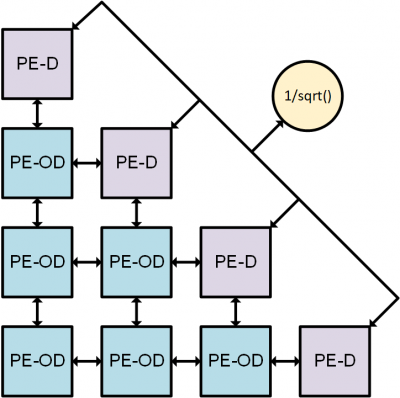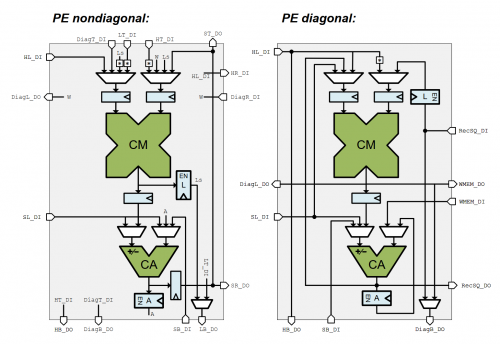ASIC implementation of a beamspace massive MIMO-OFDM detector for 5G/6G
From iis-projects
Contents
Short Description
Millimeter wave (mmWave) and massive multiple-input multiple-output (MIMO) are key technologies in 5G and beyond 5G wireless communication systems. While mmWave provides vast unused spectrum to increase the communication bandwidth, massive MIMO improves the power and spectral efficiencies via high array gain and spatial multiplexing. To deal with the inter-symbol interference caused by the frequency-selectivity of wideband wireless channels, orthogonal frequency division multiplexing (OFDM) is employed in the 5G standard [1], like many other standards such as LTE and IEEE 802.11 (WiFi). The implementation of a wideband mmWave massive MIMO-OFDM detector is challenging due to the following reasons:
- Large number of basestation (BS) antennas in massive MIMO results in large data dimensions to be processed, which makes the detection task complicated. Usually, a linear detector such as linear minimum mean squared error (LMMSE) is employed, to tame the detection complexity.
- High baseband sampling rates (in the order of Giga samples per second) that are needed to support wideband communication, generate excessive amount of data to be processed per second.
- An OFDM detector has to detect the data in the frequency domain for N ~ 1000 subcarriers. In a straightforward implementation, this requires N preprocessing operations for a linear detector, resulting in prohibitive complexity.
We have developed two main techniques to reducing the implementation complexity (i.e. silicon area and power consumption) of a wideband mmWave massive MIMO-OFDM detector:
- By exploiting the time-domain sparsity of channel impulse response, which results in smooth frequency-domain response, we use subcarrier interpolation of equalization matrices to eliminate the need to compute the equalization matrix for each subcarrier, and thereby gain considerable area and power savings [3].
- The beamspace-domain sparsity of mmWave massive MIMO channels offers an opportunity to reduce the implementation complexity of matrix-vector multiplications involving such sparse matrices and vectors [4, 5, 6].
The goal of this project is to put together the existing building blocks of the wideband beamspace massive MIMO detector with OFDM interpolation that are developed so far, in order to gain insight into how much these techniques eventually help to reduce the implementation area and power consumption of a wideband mmWave massive MIMO detector to be deployed in future wireless communication applications. The project mainly consists of Verilog HDL coding to integrate the existing building blocks and test the overall detector, as well as some fixed-point Matlab simulations to generate stimuli and expected outputs for the design. The steps of the project are as follows:
- Re-implement linear minimum mean squared error (LMMSE) preprocessing engine based on the existing design [3] using advanced fixed-point representation techniques which allow for reduced signal bitwidths resulting in reduced area/power.
- Perform row-wise scaling on the resulting LMMSE equalization matrix or convert them into a custom floating point format to reduce their bitwidth to reduce the area/power of subsequent operations.
- Build the full OFDM receiver by instantiating multiple instances of the preprocessing engine on basepoint subcarriers and performing linear interpolation on the remaining subcarries.
- Integrate the LMMSE preprocessing engines with the beamspace fast Fourier transform (FFT) [7], as well as a recently developed beamspace matrix-vector multiplication engine using a custom floating point number format, which will be provided.
- Perform functional tests to ensure proper operation and then perform backend to produce the layout of the detector.
- Perform stimuli-based power simulation in Cadence Innovus to assess the overall power savings achieved.
- If time permits, prepare the design for a tapeout.
If you are interested in improving your digital VLSI design skills, learn a lot about wireless communications and number representations with detailed matlab simulations and finally design a chip for future wireless communication systems, this project would be a great fit.
References:
[1] European Telecommunications Standards Institute, “5G NR Base Station (BS) radio transmission and reception,” Apr. 2020, 3GPP TS 38.104 version 16.4.0 Release 16
[2] C. Jeon, Z. Li and C. Studer, "Approximate Gram-Matrix Interpolation for Wideband Massive MU-MIMO Systems," in IEEE Transactions on Vehicular Technology, May 2020
[3] D. Walter, “ASIC implementation of an interpolation-based wideband massive MIMO detector,” ETH Zürich master thesis, Oct. 2023
[4] S. H. Mirfarshbafan and C. Studer, "Sparse Beamspace Equalization for Massive MU-MIMO MMWave Systems," ICASSP, Apr. 2020
[5] S. H. Mirfarshbafan and C. Studer, "SPADE: Sparsity-Adaptive Equalization for MMwave Massive MU-MIMO," IEEE Statistical Signal Processing Workshop (SSP), Aug. 2021
[6] M. Mahdavi, O. Edfors, V. Öwall and L. Liu, "Angular-Domain Massive MIMO Detection: Algorithm, Implementation, and Design Tradeoffs," in IEEE Transactions on Circuits and Systems I: Regular Papers, vol. 67, no. 6, pp. 1948-1961, June 2020
[7] S. H. Mirfarshbafan, S. Taner and C. Studer, "SMUL-FFT: A Streaming Multiplierless Fast Fourier Transform," in IEEE Transactions on Circuits and Systems II: Express Briefs
Status: Available
- Master project (shorter version possible for semester project)
- Contact: Seyed Hadi Mirfarshbafan
Prerequisites
- Verilog
- VLSI I & II
- Matlab
- Some background in wireless communications [optional]
Character
- 80% VLSI implementation
- 20% MATLAB simulation

